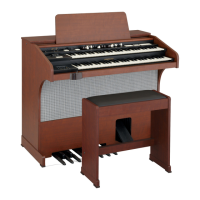75
Setting the Parameters
Vibrato and Chorus of Hammond Organs
On string instruments, the vibrato eff ect is created by changing the string tension by one’s
fi ngers. On wind instruments, by changing the strength of breath. On electronic instru-
ments with analog circuitry, by modulating the oscillator. As the rotation of the tone-
wheels of the original B-3 was stabilized by the synchronous motor, it was not possible to
provide a vibrato eff ect. On these models, the vibrato eff ect was obtained by modulating
the signal post-generator.
e vibrato & chorus system of the original B-3 consisted of a 9 stage delay line using LC
phase shift circuits. is produced a very short delay of about 1 ms. Tones were passed
through coils, delaying the phase. Several coils were connected in tandem and when the
output of each tap was passed from the top to the last by turns, the pitches gradually low-
ered. By taking the output of each tap from the last to the top by turns on the contrary,
the pitch would gradually rise. ese operations were automatically made by turning the
scanner with a motor.
e scanner was used to select one of multiple input terminals by the static connection.
As each terminal was selected by the “blades” which approached each other, a popping
noise like that of a switch did not occur and the signals of neighboring terminals cross-
faded and switched themselves.
e mode-selection of vibrato eff ects was made by changing the range of the connecting
tap.
As this system modulated the produced tonal signals and not the oscillator, the original
sound could be heard without the vibrato eff ect. By mixing the sound with the vibrato
eff ect and the original sound, the chorus eff ect was obtained.
On this model, the chorus and vibrato eff ects are simulated and modeled in the original
fashion digitally, by the DSP, without using moving parts.
Hammond Classic “Scanner Vibrato” (Physically Modeled on the A-405SP)

